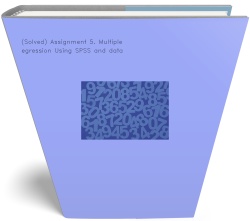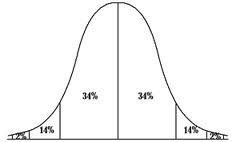Treatment Placebo 12 8 10 5 6 9 9 4 15 6 12 14 We wish to compare hemoglobins in malnourished adults receiving
Problem 1
| Treatment | Placebo |
| 12 | 8 |
| 10 | 5 |
| 6 | 9 |
| 9 | 4 |
| 15 | 6 |
| 12 | |
| 14 |
We wish to compare hemoglobins in malnourished adults receiving iron supplements to those receiving placebo.
Answer the following:
-
What type of data is this?
- Nominal
- Ordinal
- Continuous
- Is the data normally or not normally distributed?
- How many groups are being analyzed?
- If 2 or more groups, are they independent or repeated measures?
-
Please perform the analysis using both the most appropriate parametric test and its nonparametric equivalent. Do this using SPSS.
Print out the syntax and SPSS output for each. Label and Hand in the Syntax . -
Interpret the SPSS output in each case:
- List the test statistic
- List the p-value
- Determine if you would accept or reject the null hypothesis
-
For the parametric test:
- Write the equation for the test statistic.
- Use the SPSS output in the above equation to calculate the test statistic by hand. Show all work.
- Interpret the confidence interval
- Which test (parametric or non-parametric) was most appropriate and why?
Problem 2
| Happiness before pet | Happiness after pet |
| 10 | 15 |
| 9 | 9 |
| 11 | 10 |
| 11 | 19 |
| 5 | 17 |
| 9 | 15 |
We wish to compare happiness in pet owners. Happiness was measured before and after people required a pet at a local animal shelter.
Answer the following:
-
What type of data is this?
- Nominal
- Ordinal
- Continuous
- Is the data normally or not normally distributed?
- How many groups are being analyzed?
- If 2 or more groups, are they independent or repeated measures?
-
Please perform the analysis using both the most appropriate parametric test and its nonparametric equivalent. Do this using SPSS.
Print out the syntax and SPSS output for each. Label and Hand in the Syntax. -
Interpret the SPSS output in each case:
- List the test statistic
- List the p-value
- Determine if you would accept or reject the null hypothesis
-
For the parametric test:
- Write the equation for the test statistic.
- Use the SPSS output in the above equation to calculate the test statistic by hand. Show all work.
- Interpret the confidence interval
- Which test (parametric or non-parametric) was most appropriate and why?
Problem 3
| Treatment in center based program | Treatment in home | Treatment in both |
| 1 | 2 | 4 |
| 1 | 7 | 1 |
| 5 | 2 | 2 |
| 2 | 4 | 2 |
| 1 | 5 | 6 |
We wish to compare response to treatment in children with autism. Children are randomized to receive treatment in a center, home or both.
Answer the following:
-
What type of data is this?
- Nominal
- Ordinal
- Continuous
- Assume that this data is known to have been sampled from a normally distributed population.
- How many groups are being analyzed?
- If 2 or more groups, are they independent or repeated measures?
- Please perform the analysis using both the most appropriate parametric test and its nonparametric equivalent. Do this using SPSS.
- Print out the syntax and SPSS output for each. Label and Hand in the Syntax.
-
Interpret the SPSS output in each case:
- List the test statistic
- List the p-value
- Determine if you would accept or reject the null hypothesis
-
For the parametric test:
- Write the equation for the test statistic.
-
Use the SPSS output in the above equation to calculate the test statistic by hand. Show all work.
iii.Please do a post-hoc analysis to determine which groups are different from which other groups.
- Which test (parametric or non-parametric) was most appropriate and why?
Problem 4
We wish to study different levels of intensity of treatment for obesity. Adults are randomized to receive high intensity treatment, low intensity treatment or no treatment. In this analysis, we will compare controls and low intensity treatment subjects. Use the attached database (question 4) to answer the following:
-
What type of data is this?
- Nominal
- Ordinal
- Continuous
- Dichotomize BMI – consider BMI > 30 to be overweight and less than 30 to be normal. Now what kind of data is this?
- Filter the data so as to only include controls and low intensity treatment subjects. How many groups are being analyzed?
- If 2 or more groups, are they independent or repeated measures?
-
Analyze effects of treatment on the dichotomized data.
Do this using SPSS.
Print out the syntax and SPSS output for each. Label and Hand in the Syntax. -
Interpret the SPSS output:
- Identify two tests that might be appropriate that are on the output page. List the assumptions (if any) for each test and determine for each whether these assumptions have been met.
- List the p-value for each
- Determine if you would accept or reject the null hypothesis for each
Problem 5
| TV hours per week | Behavior problems |
| 5.00 | 30.00 |
| 10.00 | 20.00 |
| 10.00 | 60.00 |
| 15.00 | 40.00 |
| 15.00 | 60.00 |
| 20.00 | 40.00 |
| 20.00 | 80.00 |
| 25.00 | 70.00 |
| 5.00 | 30.00 |
We wish to determine whether there is a relationship between the number of TV hours watched per week and behavior problems in school age children.
Answer the following:
1. What type of data is this?
- Nominal
- Ordinal
- Continuous
2. Is the data normally or not normally distributed?
3. Please perform the analysis using both the most appropriate parametric test and its nonparametric equivalent. Do this using SPSS.
Print out the syntax and SPSS output for each. Label and Hand in the Syntax.
4 . Interpret the SPSS output in each case:
- List the test statistic
- List the p-value
- Determine if you would accept or reject the null hypothesis
- For the parametric test, what is the direction of the relationship, and what is the magnitude of association (effect size)
5 . Which test (parametric or non-parametric) was most appropriate and why?
Problem 6
1 . Re-analyze data from Problem 5 using linear regression. Do this in SPSS.
2. Print out the syntax and SPSS output for each. Label and Hand in the Syntax.
3 . Interpret the SPSS output:
- What is the independent variable? What is the dependent variable? Why?
-
What is the R and R-squared for the regression?
How are the two related? What is the amount of variability that is predicted by the regression? - List the F-statistic and the p-value for the regression.
- Interpret the B for the predictor variable – both magnitude and significance
4 . Write out a linear regression equation based on the output.
5 . What would you predict the behavior score would be for a child who watches tv for 12 hours per week?
Question 7
| TV hours per week | Difficult temperament score | Behavior problems |
| 5 | 2 | 30 |
| 10 | 0 | 20 |
| 10 | 4 | 60 |
| 15 | 0 | 40 |
| 15 | 3 | 60 |
| 20 | 2 | 40 |
| 20 | 4 | 80 |
| 25 | 2 | 70 |
| 5 | 2 | 30 |
1. Use multiple regression to determine whether TV hours per week and/or difficult temperament predict behavior problems. Do this in SPSS.
2. Print out the syntax and SPSS output for each. Label and Hand in the Syntax.
3 . Interpret the SPSS output:
- What is/are the independent variable(s)? What is/are the dependent variable(s)? Why?
- What is the R and R-squared for the regression? How are the two related? What is the amount of variability that is predicted by the regression?
- List the F-statistic and the p-value for the regression.
- Interpret the B for each predictor variable – both magnitude and significance
4 . Write out a linear regression equation based on the output.
5 . What would you predict the behavior score would be for a child who watches tv for 12 hours per week and has a difficult temperament score of 1?
Deliverable: Word Document




![[Solution] Define [Solution] Define](/images/solutions/MC-solution-library-81005.jpg)

![[Solution] Project Template Study Purpose In this section, you [Solution] Project Template Study Purpose In this](/images/solutions/MC-solution-library-81007.jpg)
